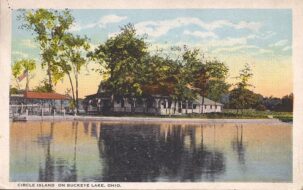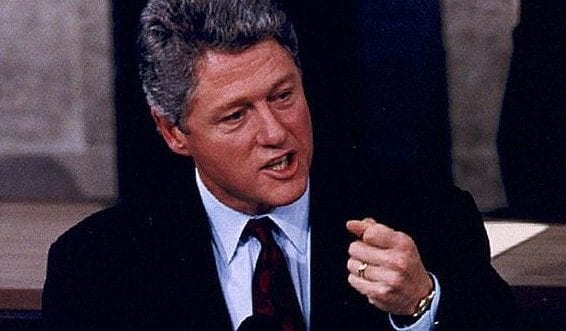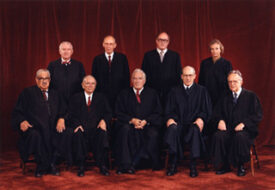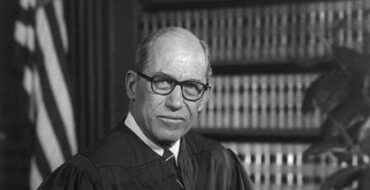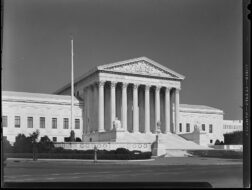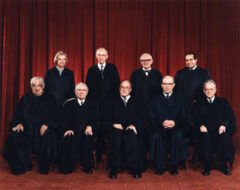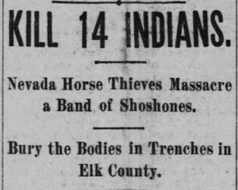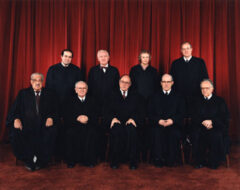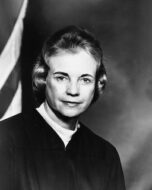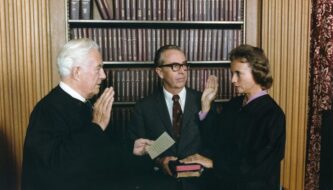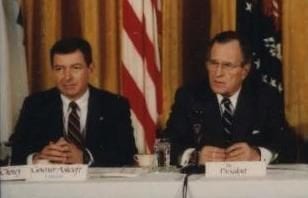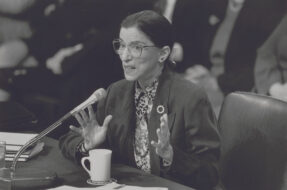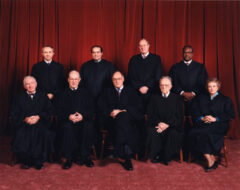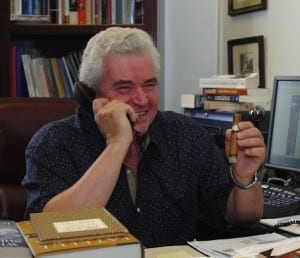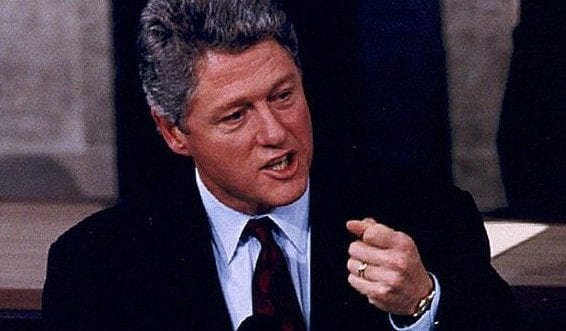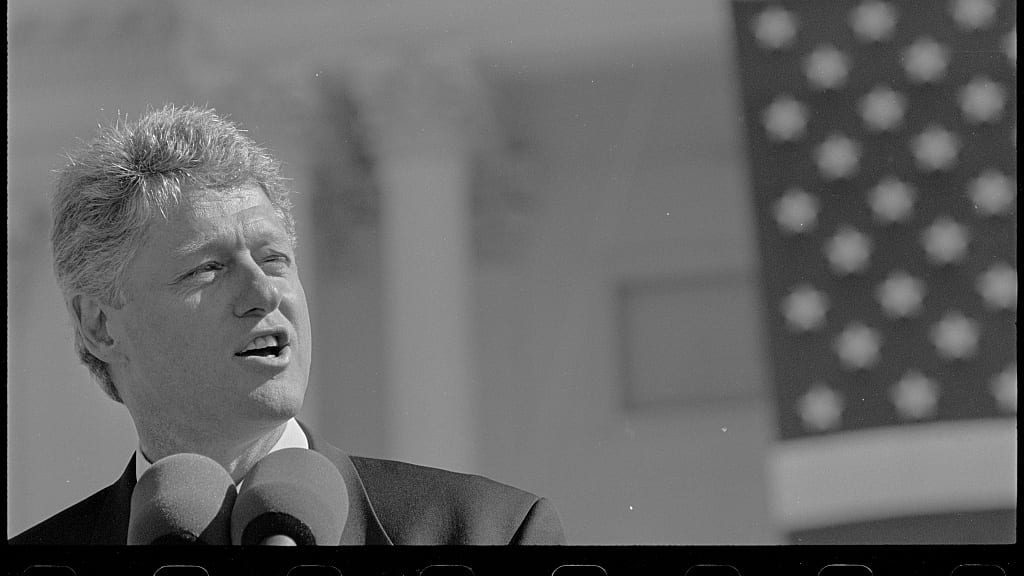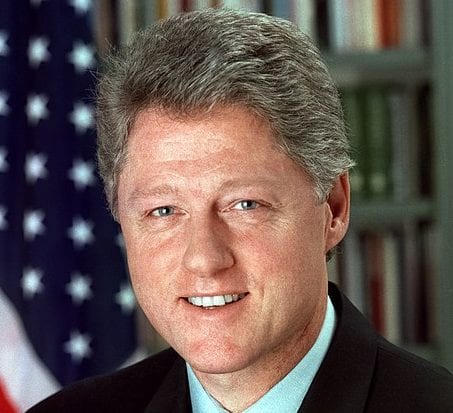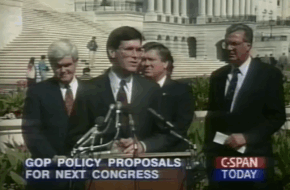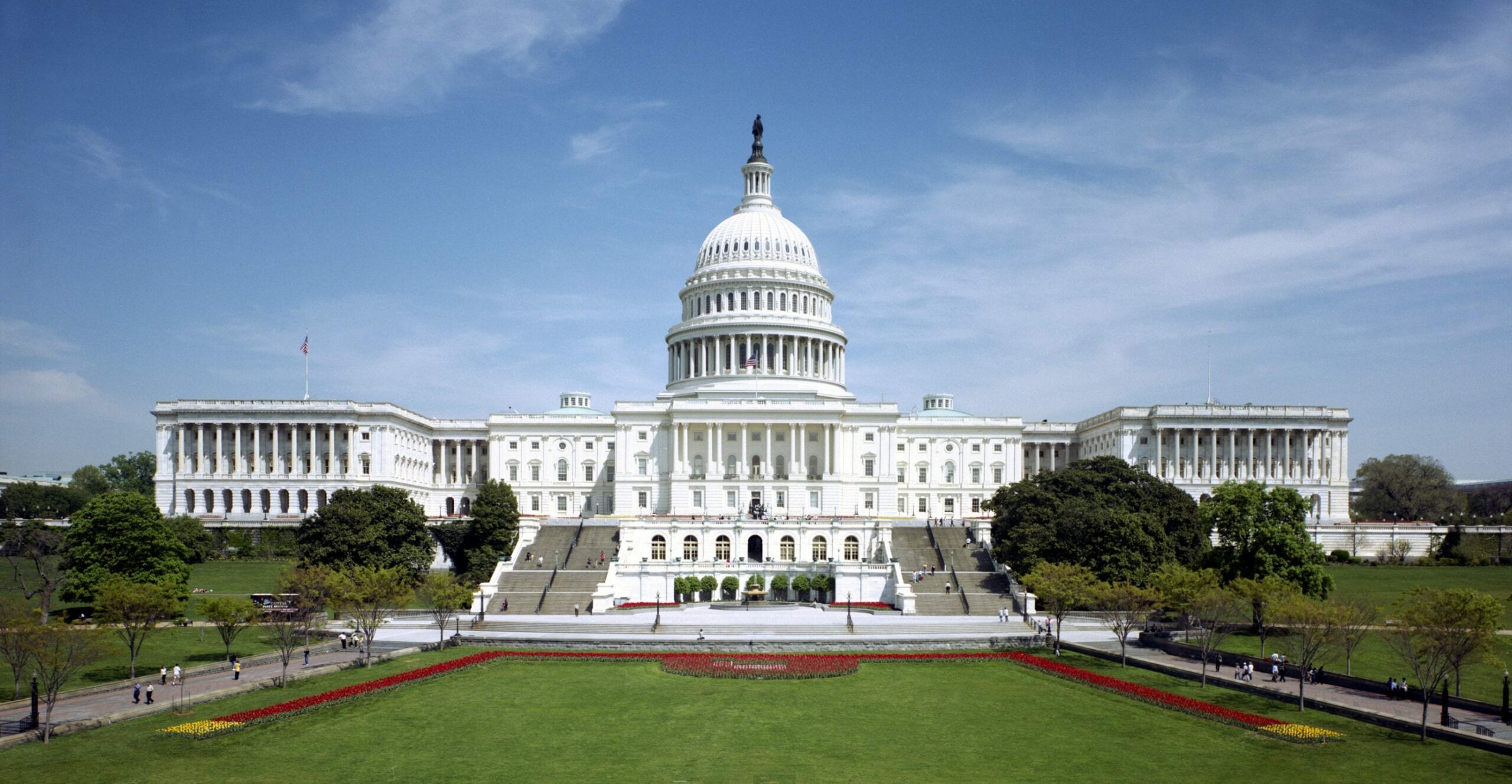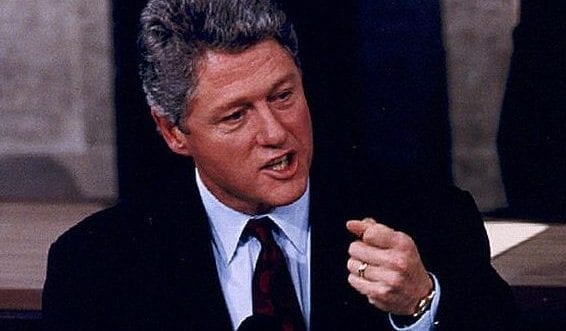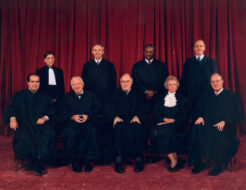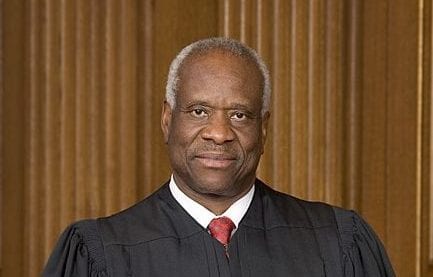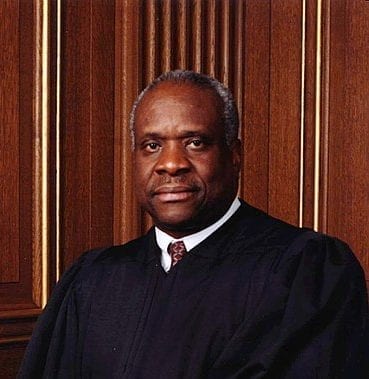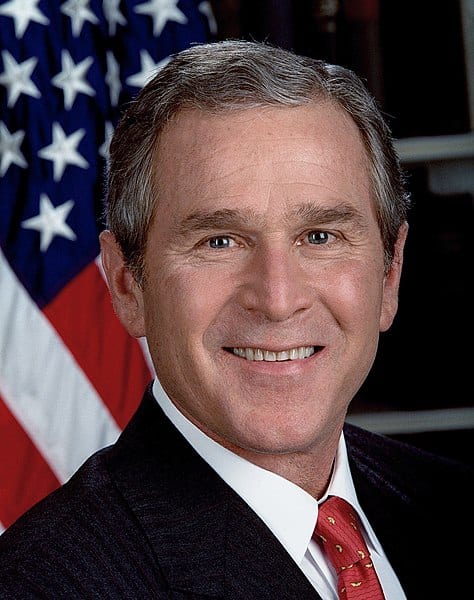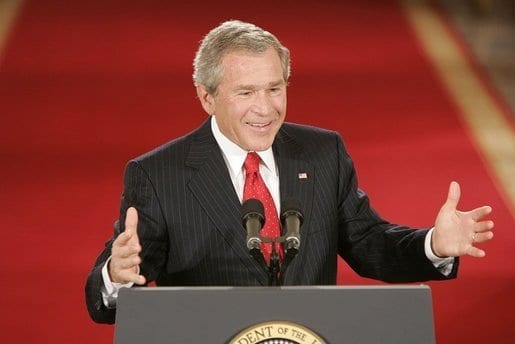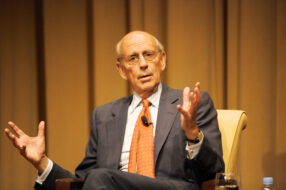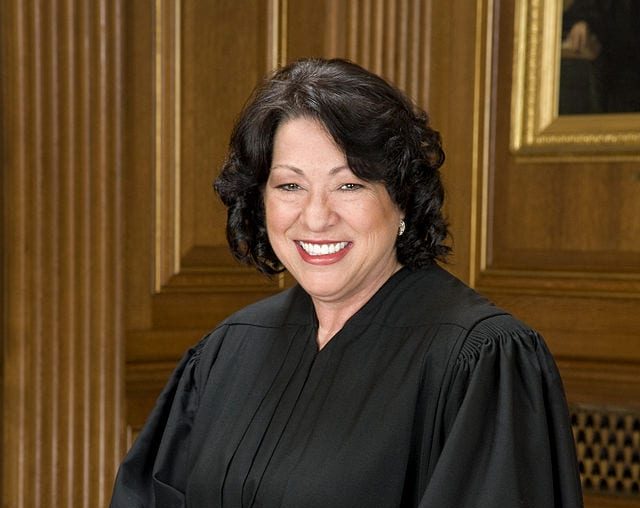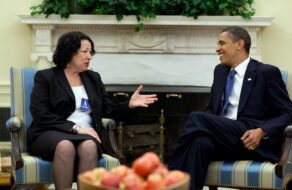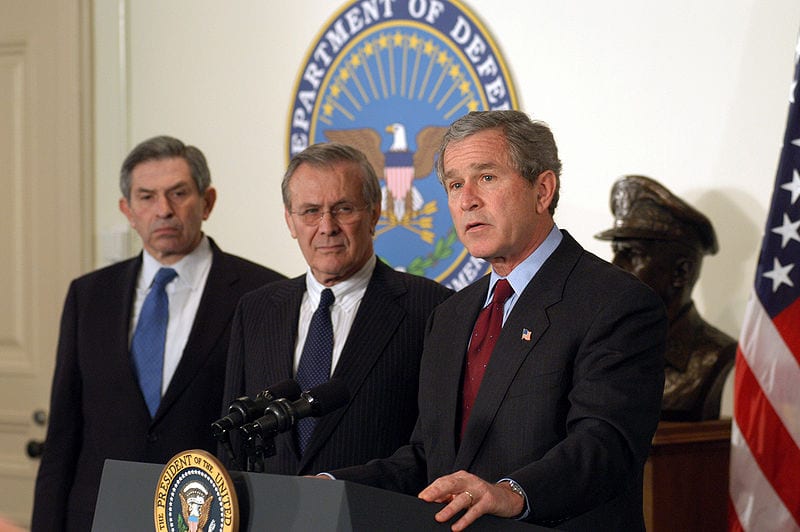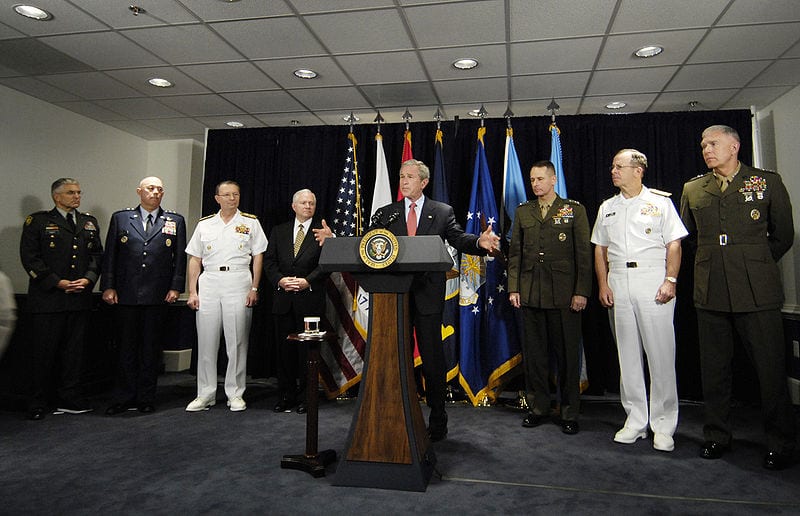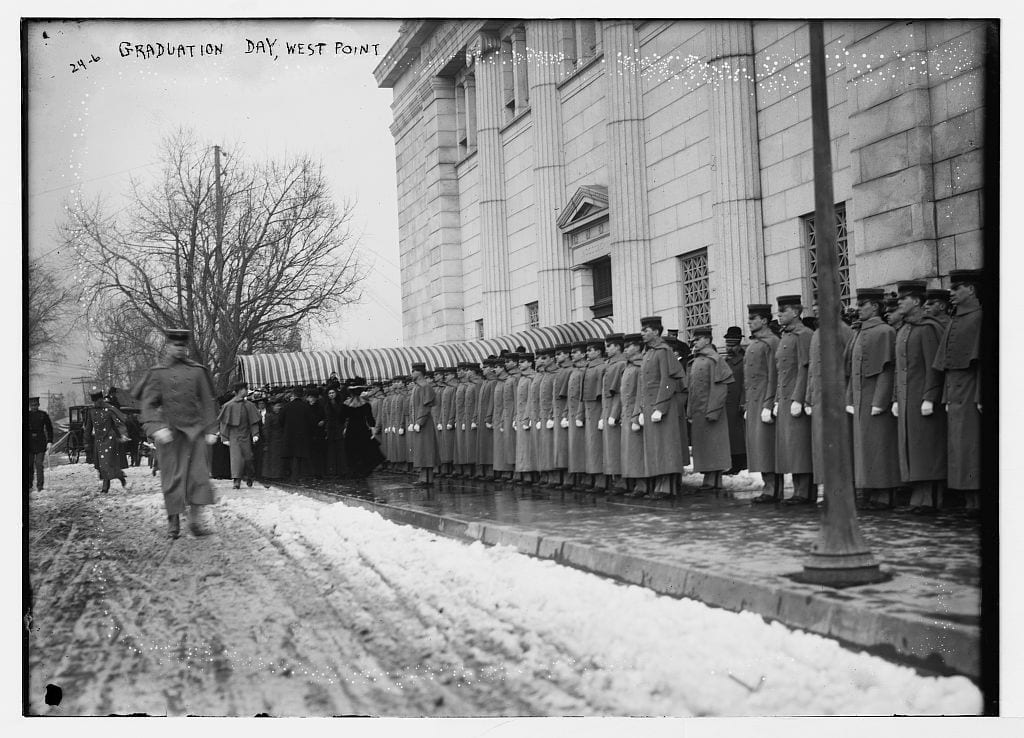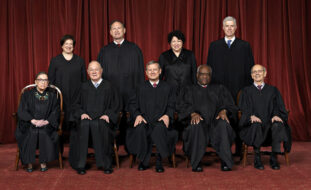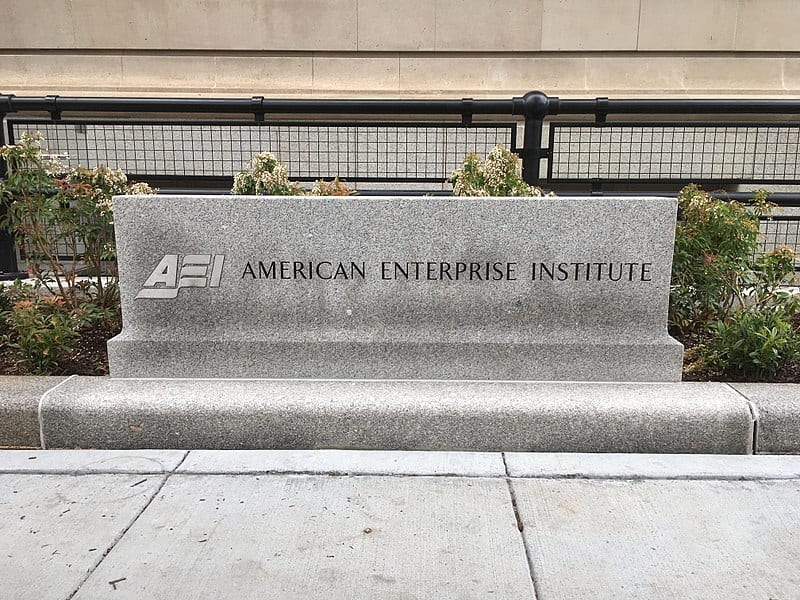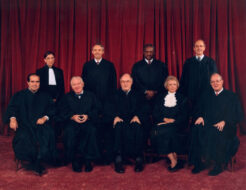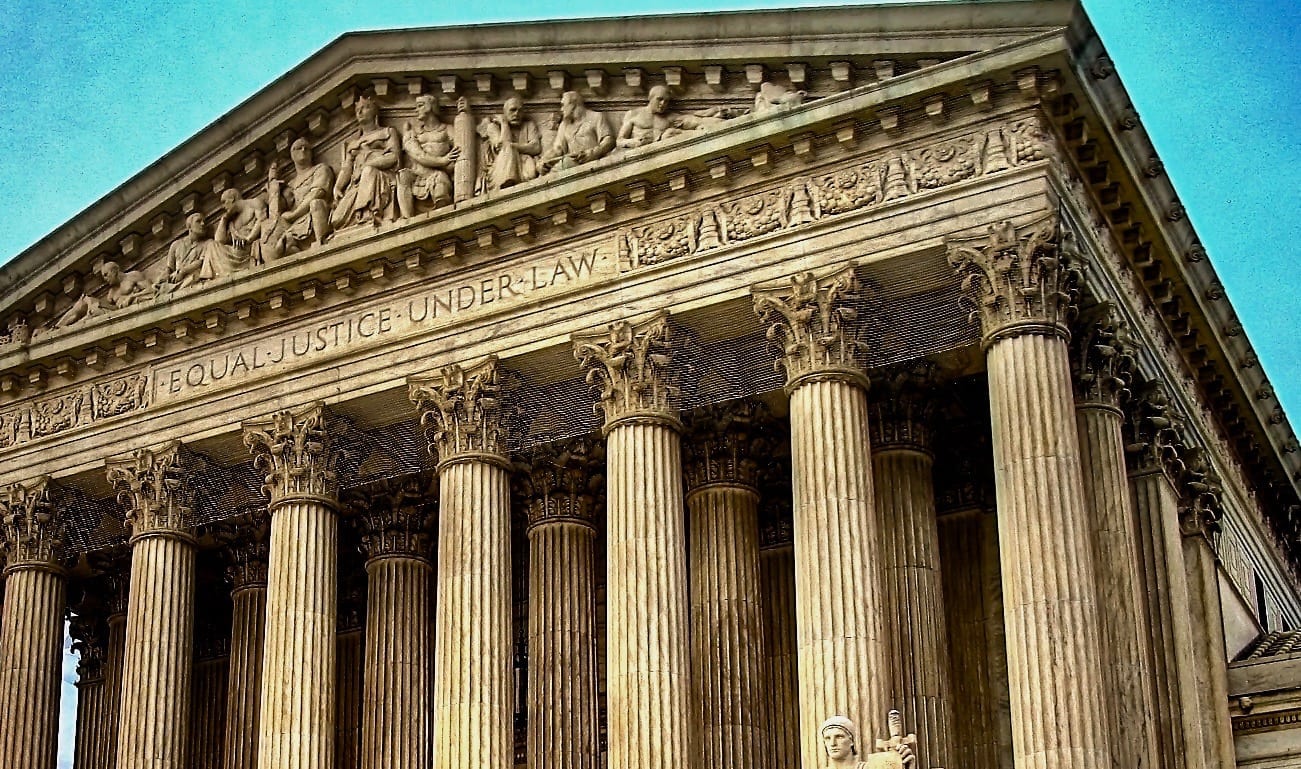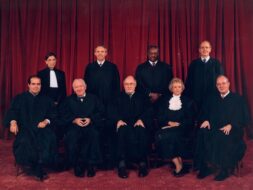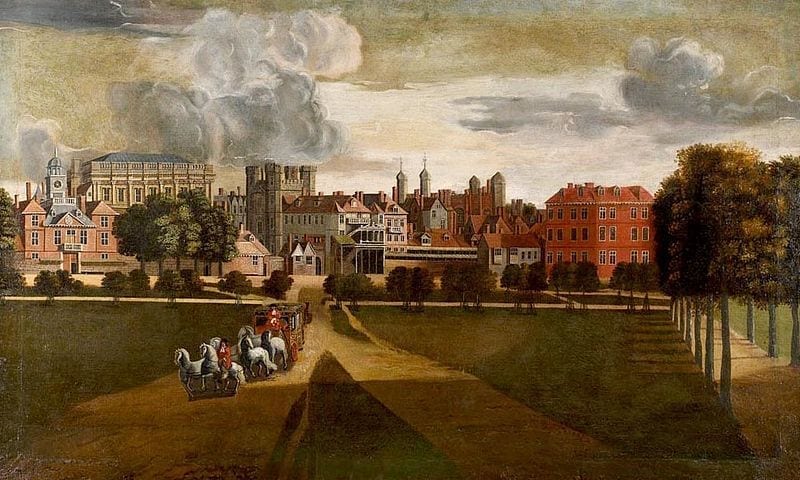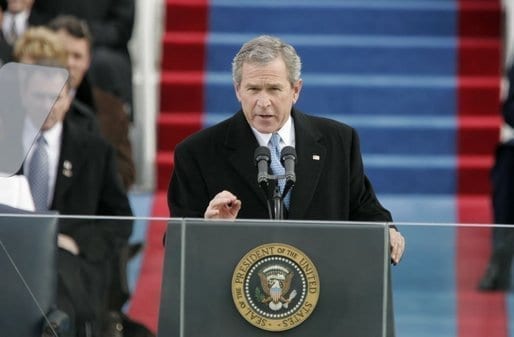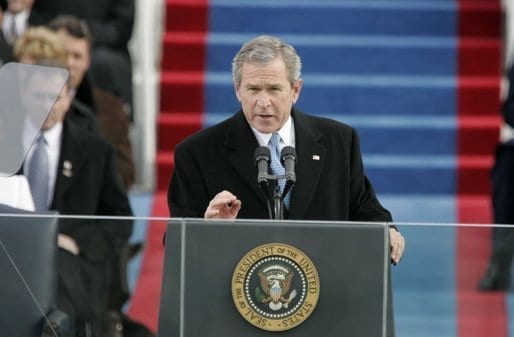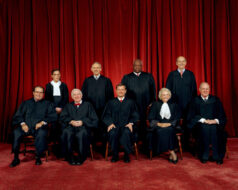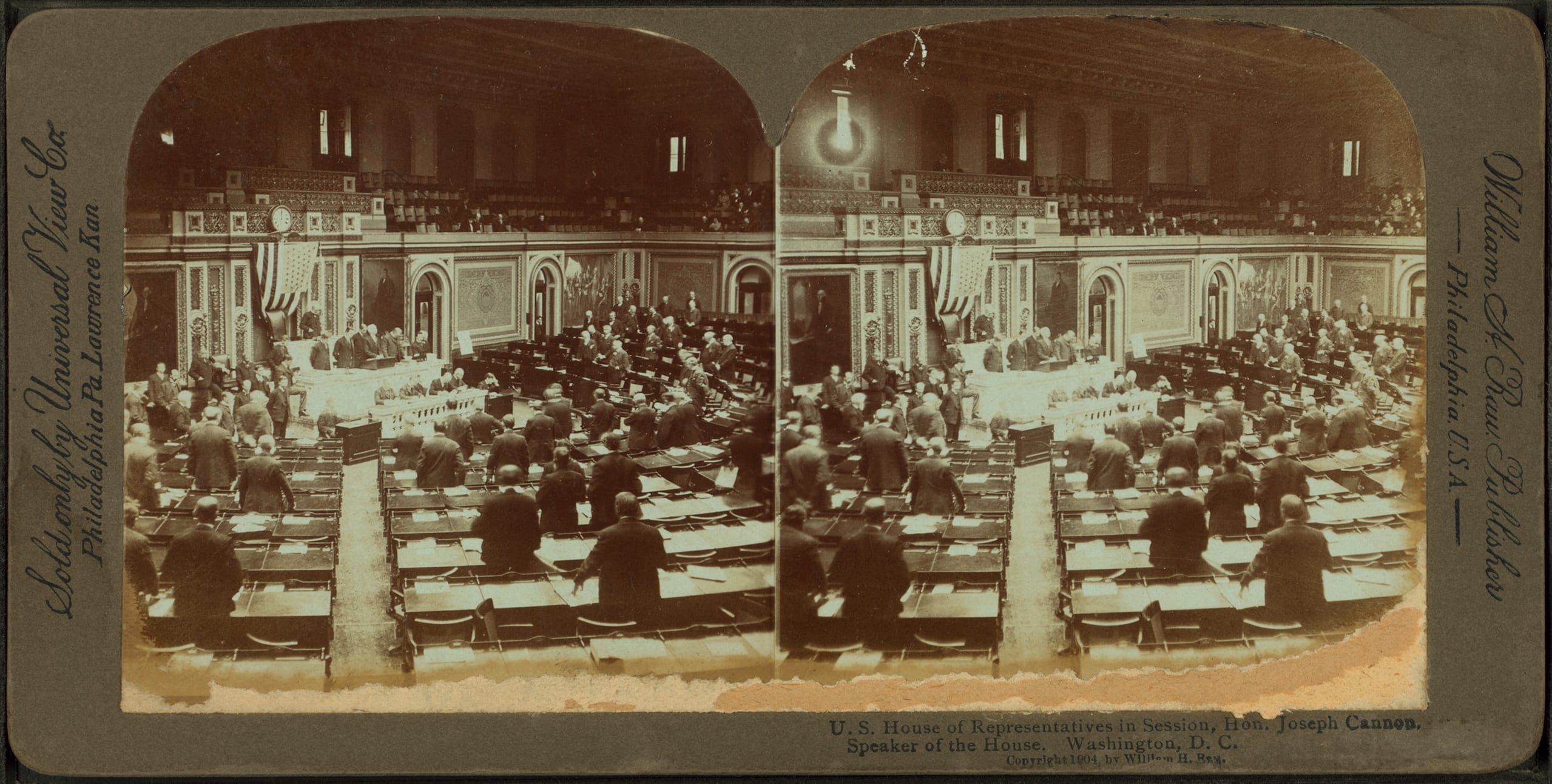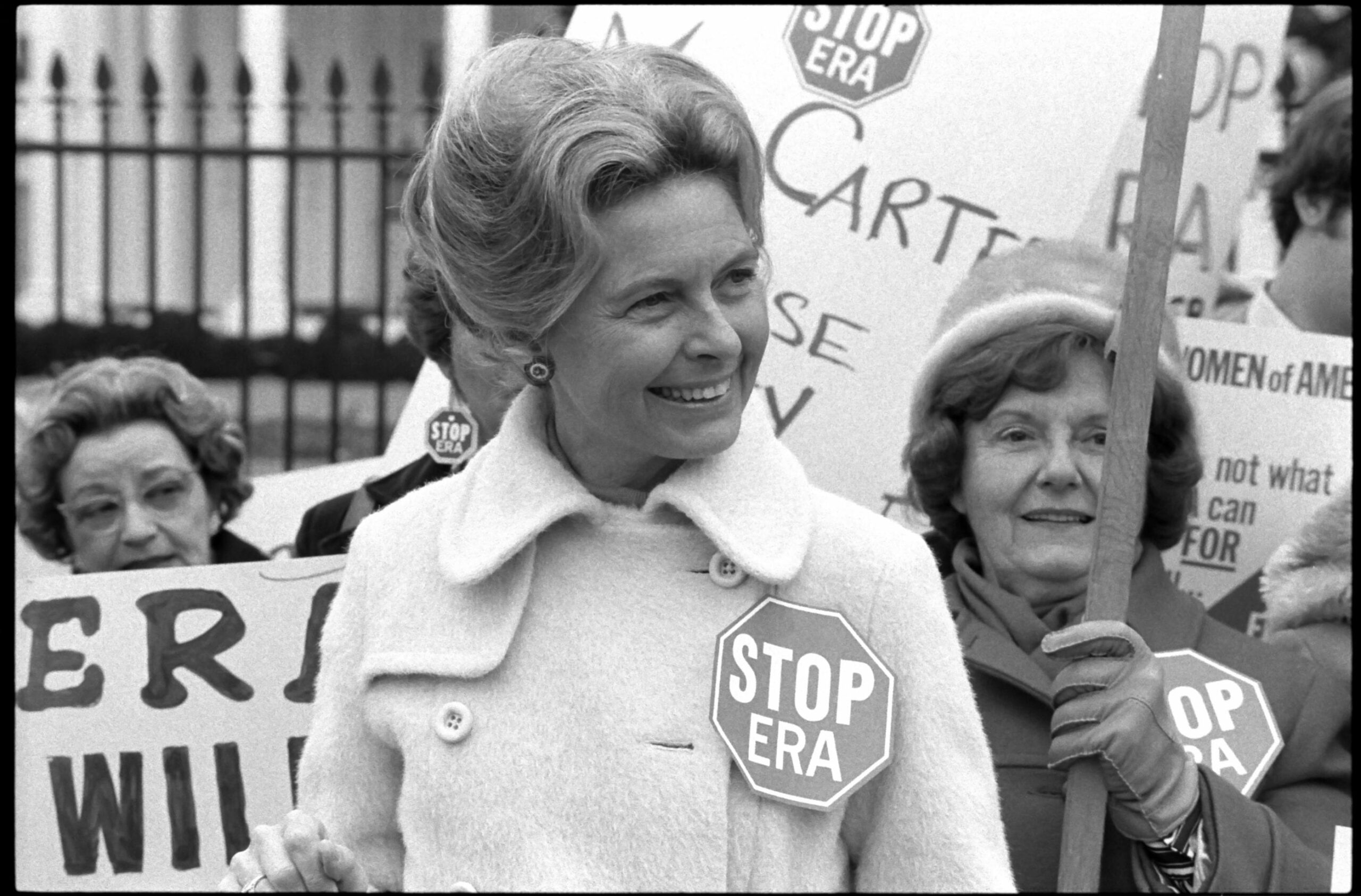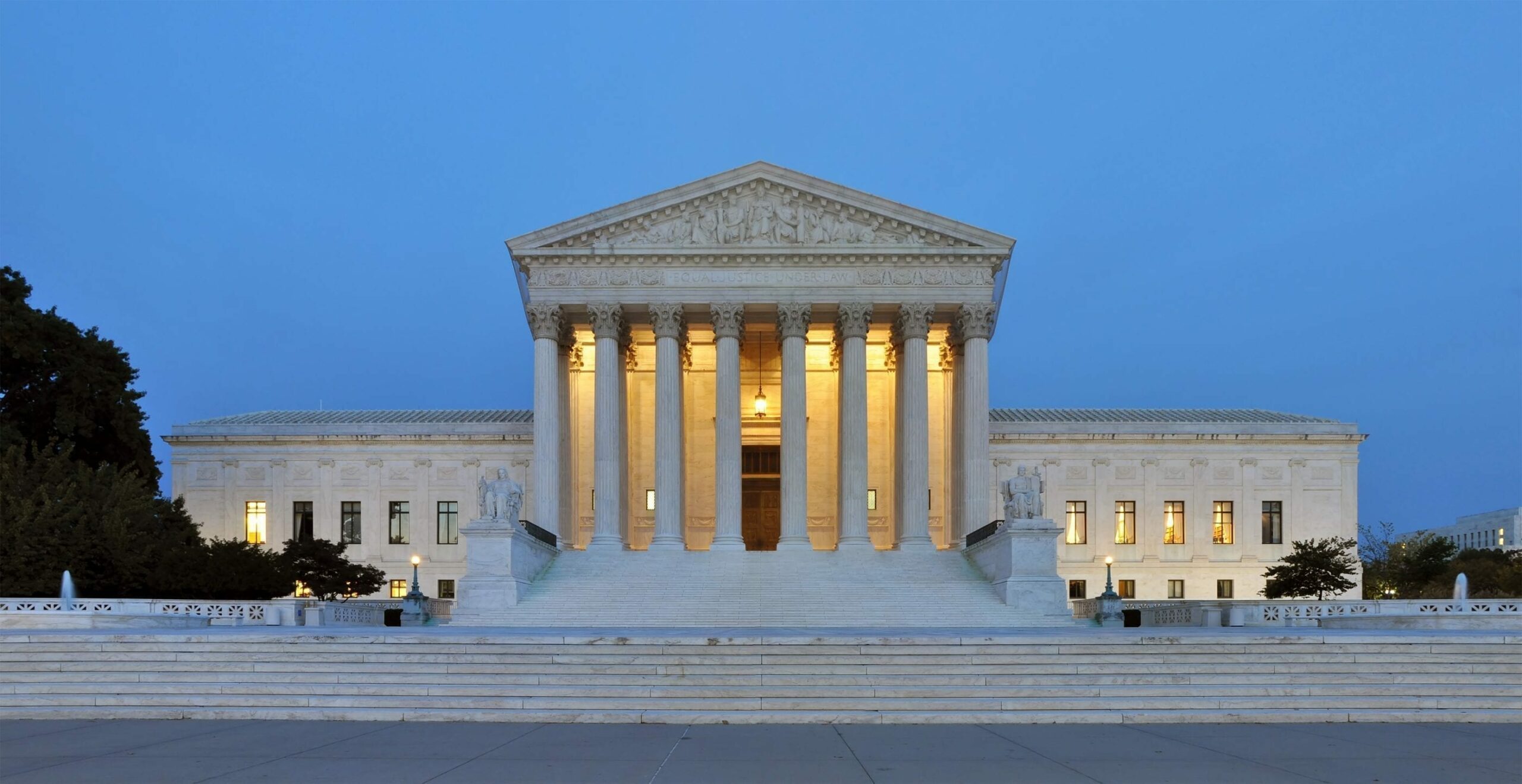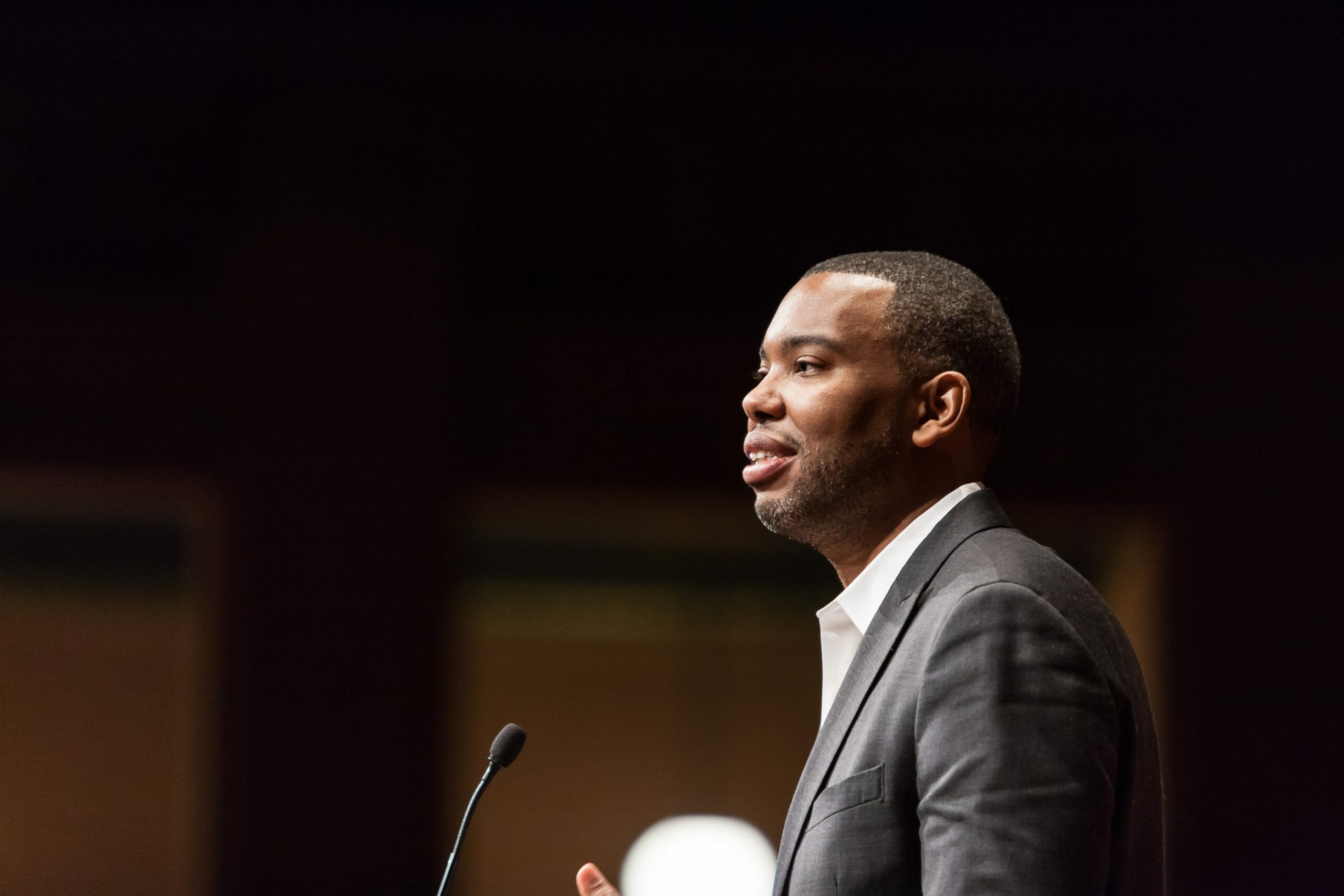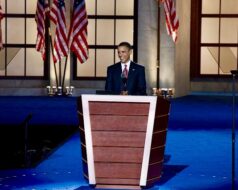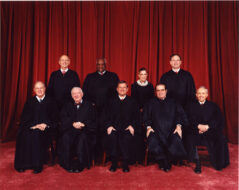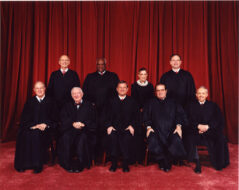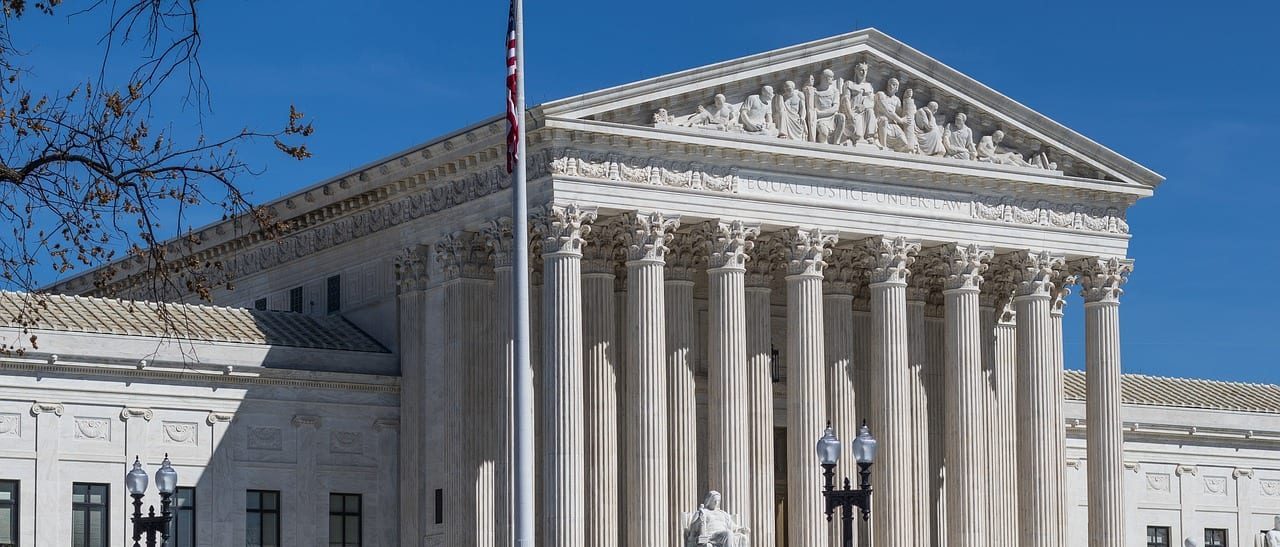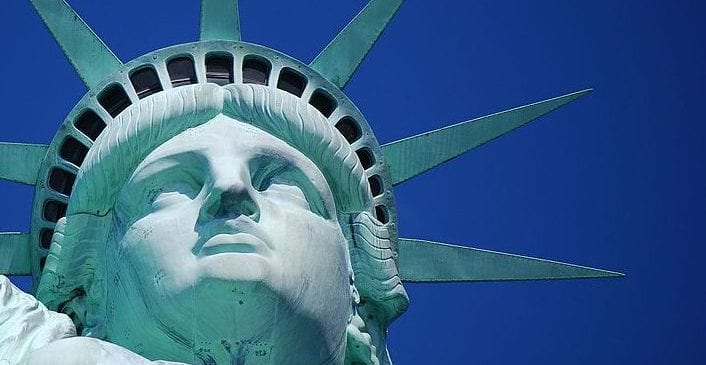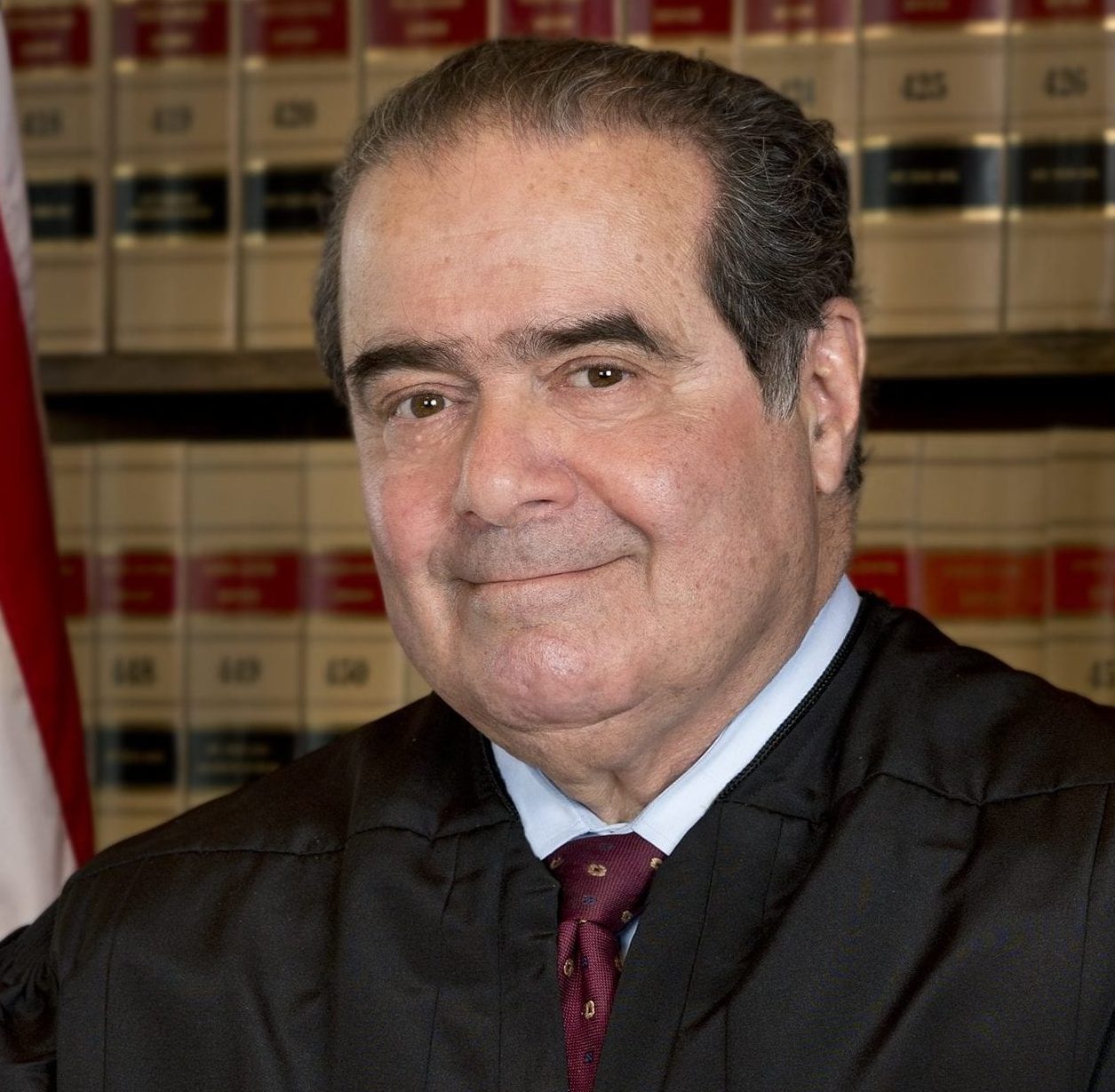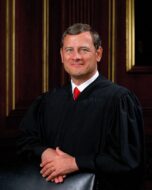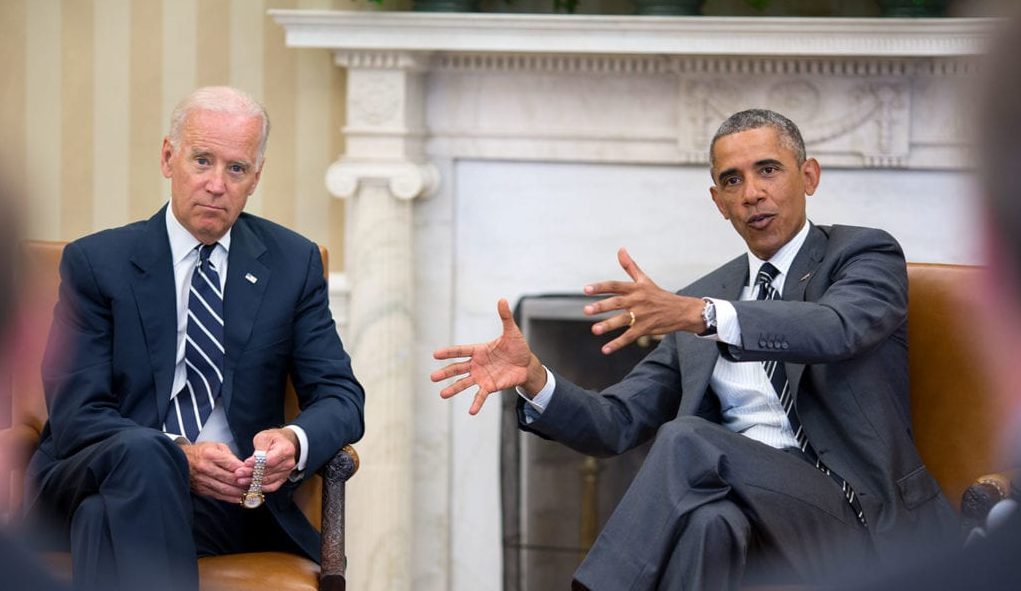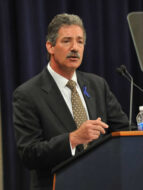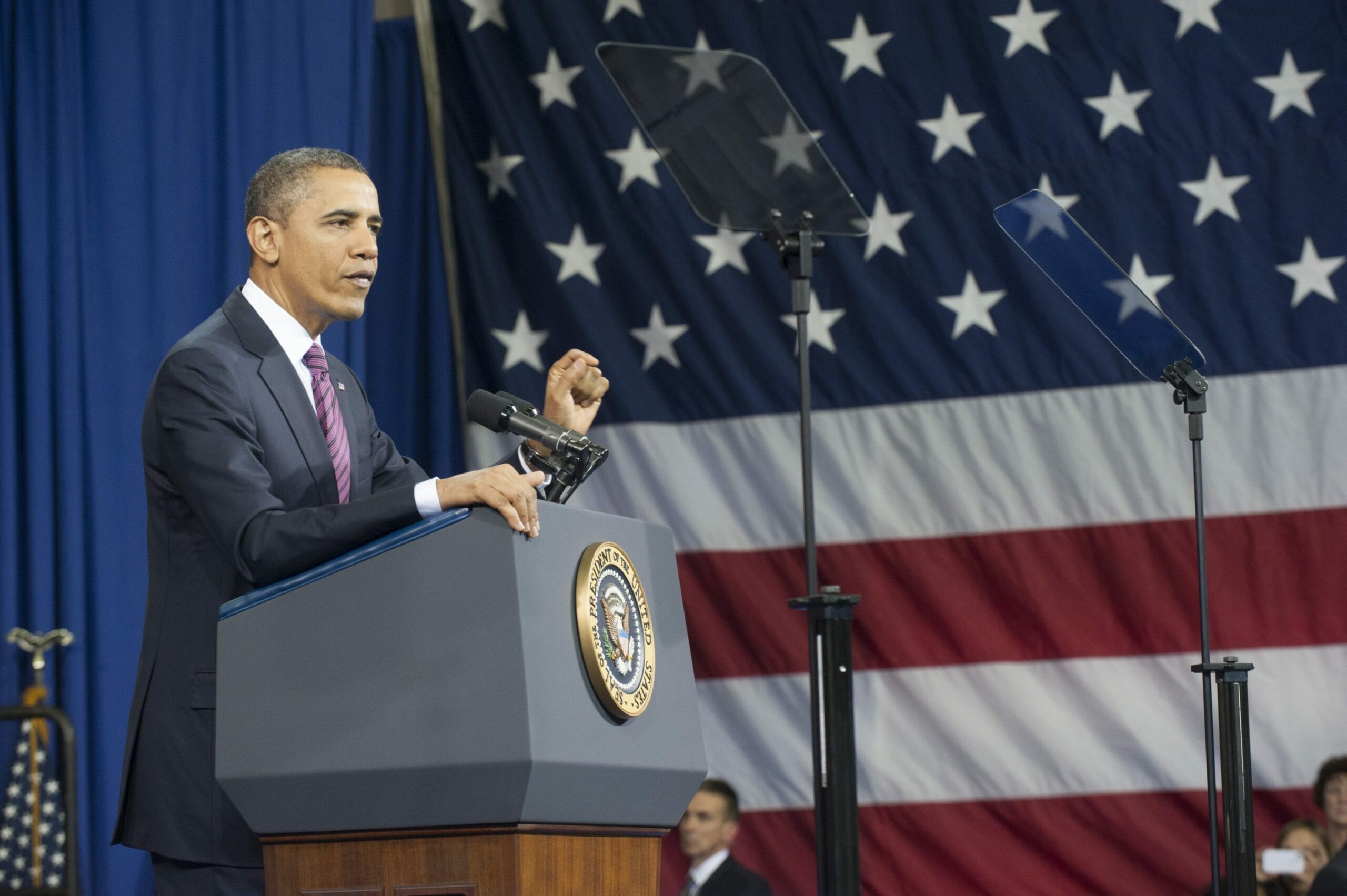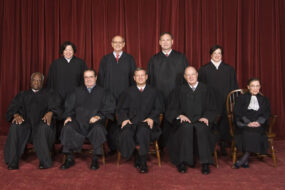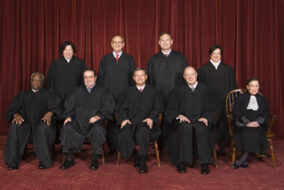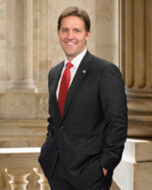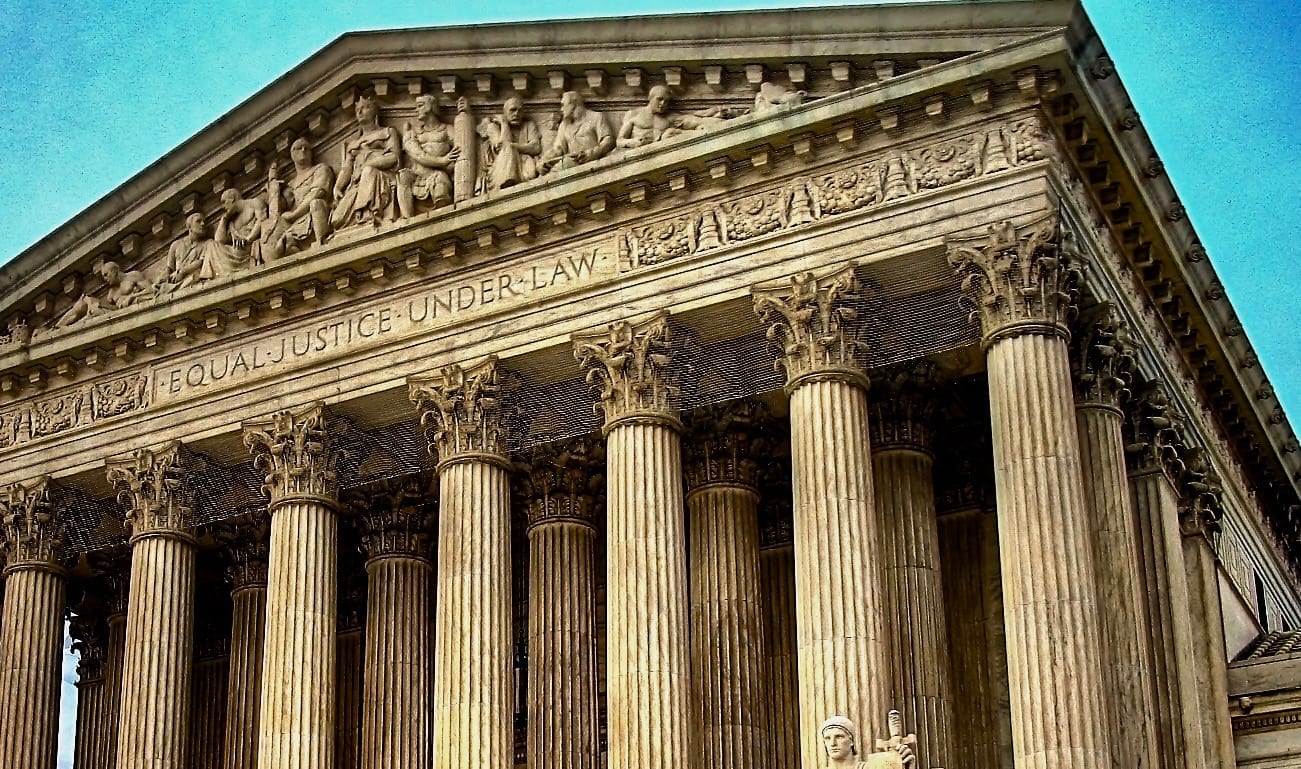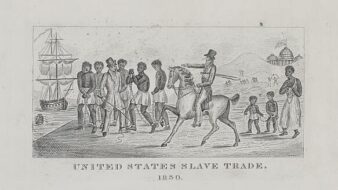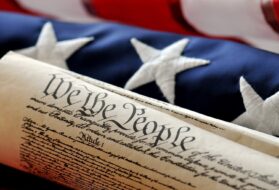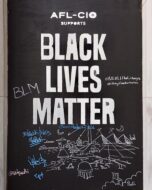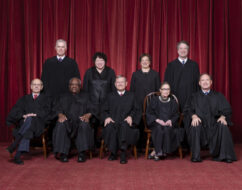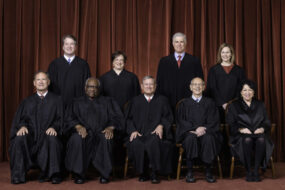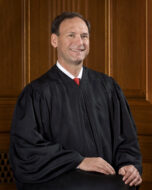

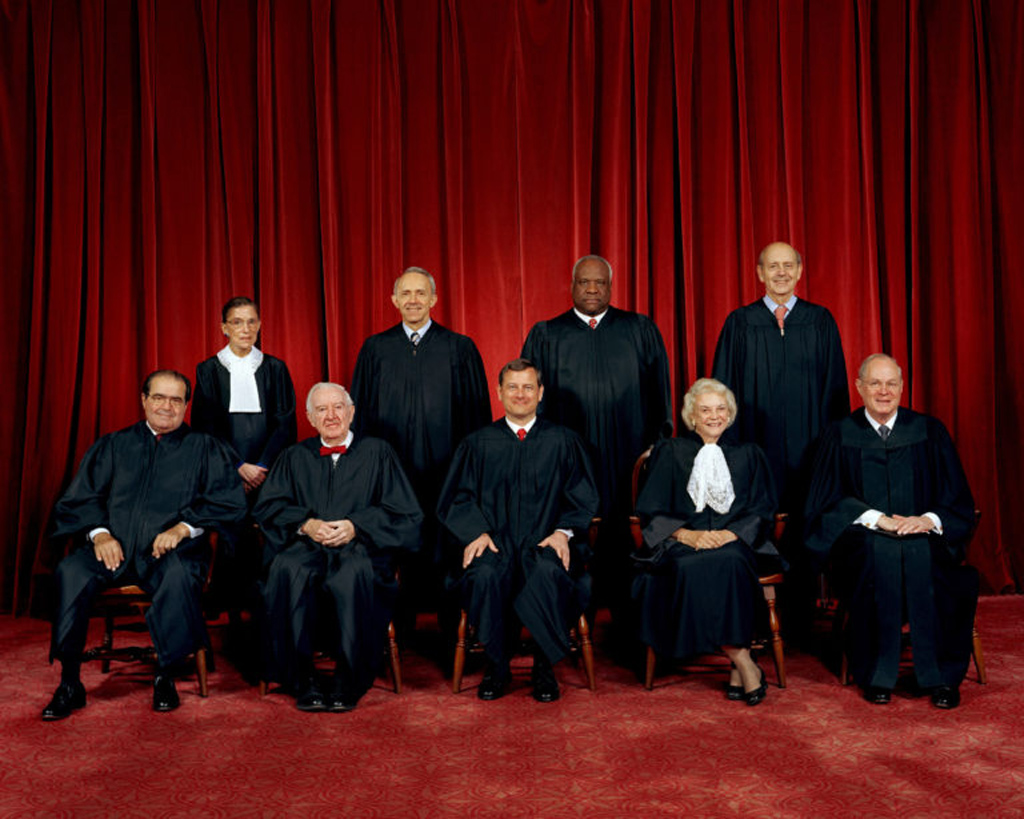
No related resources
Introduction
Justice David H. Souter presents the facts of the case, decided 5-4, along with Van Orden v. Perry, on the same day. Here the Court struck down a Kentucky courthouse display of the Ten Commandments as a violation of the Establishment Clause. Justice Stephen G. Breyer explained his change of vote from supporting the Ten Commandments monument near the Texas Capitol in companion case of Van Orden v. Perry: The Capitol display was more like a museum display, while the courthouse display was intended to make a statement about a particular religion. The Court opinion and the dissents likewise change places. Justice Souter dissented in Van Orden v. Perry, but wrote the Court’s opinion in this case. Justice Antonin Scalia concurred in the Court’s opinion in Van Orden, but dissented in this case. The arguments in these cases about monuments have implications for future cases about religious symbols on public land, such as crosses as memorials to fallen soldiers.
Source: 545 U.S. 844, https://www.law.cornell.edu/supct/html/03-1693.ZS.html. We include the opinions of Justices Souter and Scalia but omit the concurrence of Justice Sandra Day O’Connor. Footnotes added by the editors are preceded by “Ed. note.”
Justice Souter delivered the opinion of the Court.
Executives of two [Kentucky] counties posted a version of the Ten Commandments on the walls of their courthouses. After suits were filed charging violations of the Establishment Clause, the legislative body of each county adopted a resolution calling for a more extensive exhibit meant to show that the Commandments are Kentucky’s “precedent legal code.” The result in each instance was a modified display of the Commandments surrounded by texts containing religious references as their sole common element. After changing counsel, the counties revised the exhibits again by eliminating some documents, expanding the text set out in another, and adding some new ones.
The issues are whether a determination of the counties’ purpose is a sound basis for ruling on the Establishment Clause complaints, and whether evaluation of the counties’ claim of secular purpose for the ultimate displays may take their evolution into account. We hold that the counties’ manifest objective may be dispositive of the constitutional enquiry, and that the development of the presentation should be considered when determining its purpose.
I
In the summer of 1999, petitioners[1] McCreary County and Pulaski County, Kentucky (hereinafter counties), put up in their respective courthouses large, gold-framed copies of an abridged text of the King James version of the Ten Commandments, including a citation to the Book of Exodus. In McCreary County, the placement of the Commandments responded to an order of the county legislative body requiring “the display [to] be posted in ‘a very high traffic area’ of the courthouse.” In Pulaski County, amidst reported controversy over the propriety of the display, the Commandments were hung in a ceremony presided over by the county judge-executive, who called them “good rules to live by” and who recounted the story of an astronaut who became convinced “there must be a divine God” after viewing the Earth from the moon. The judge-executive was accompanied by the pastor of his church, who called the Commandments “a creed of ethics” and told the press after the ceremony that displaying the Commandments was “one of the greatest things the judge could have done to close out the millennium.” . . .
In each county, the hallway display was “readily visible to . . . county citizens who use the courthouse to conduct their civic business, to obtain or renew driver’s licenses and permits, to register cars, to pay local taxes, and to register to vote.” 96 F. Supp. 2d., at 684; American Civil Liberties Union of Kentucky v. Pulaski County, Kentucky,96 F. Supp. 2d 691, 695 (ED Ky. 2000). . . .
As directed by the resolutions [of county authorities], the counties expanded the displays of the Ten Commandments in their locations, presumably along with copies of the resolution, which instructed that it, too, be posted. In addition to the first display’s large framed copy of the edited King James version of the Commandments, the second included eight other documents in smaller frames, each either having a religious theme or excerpted to highlight a religious element. The documents were the “endowed by their Creator” passage from the Declaration of Independence; the Preamble to the Constitution of Kentucky; the national motto, “In God We Trust”; a page from the Congressional Record of February 2, 1983, proclaiming the Year of the Bible and including a statement of the Ten Commandments; a proclamation by President Abraham Lincoln designating April 30, 1863, a National Day of Prayer and Humiliation; an excerpt from President Lincoln’s “Reply to Loyal Colored People of Baltimore upon Presentation of a Bible,” reading that “[t]he Bible is the best gift God has ever given to man”; a proclamation by President Reagan marking 1983 the Year of the Bible; and the Mayflower Compact.
After argument, the district court entered a preliminary injunction on May 5, 2000, ordering that the “display . . . be removed from [each] County Courthouse IMMEDIATELY” and that no county official “erect or cause to be erected similar displays.” . . . The court found that the second version [the expanded display] also “clearly lack[ed] a secular purpose” because the “count[ies] narrowly tailored [their] selection of foundational documents to incorporate only those with specific references to Christianity.”
The counties filed a notice of appeal from the preliminary injunction but voluntarily dismissed it after hiring new lawyers. They then installed another display in each courthouse, the third within a year. No new resolution authorized this one, nor did the counties repeal the resolutions that preceded the second. The posting consists of nine framed documents of equal size, one of them setting out the Ten Commandments explicitly identified as the “King James Version” at Exodus 20:3 and quoted at greater length than before:
Thou shalt have no other gods before me.
Thou shalt not make unto thee any graven image, or any likeness of any thing that is in heaven above, or that is in the earth beneath, or that is in the water underneath the earth: Thou shalt not bow down thyself to them, nor serve them: for I the LORD thy God am a jealous God, visiting the iniquity of the fathers upon the children unto the third and fourth generation of them that hate me.
Thou shalt not take the name of the LORD thy God in vain: for the LORD will not hold him guiltless that taketh his name in vain.
Remember the sabbath day, to keep it holy.
Honour thy father and thy mother: that thy days may be long upon the land which the LORD thy God giveth thee.
Thou shalt not kill.
Thou shalt not commit adultery.
Thou shalt not steal.
Thou shalt not bear false witness against thy neighbour.
Thou shalt not covet thy neighbour’s house, thou shalt not covet th[y] neighbor’s wife, nor his manservant, nor his maidservant, nor his ox, nor his ass, nor anything that is th[y] neighbour’s.”
Assembled with the Commandments are framed copies of the Magna Carta, the Declaration of Independence, the Bill of Rights, the lyrics of the Star Spangled Banner, the Mayflower Compact, the National Motto, the Preamble to the Kentucky Constitution, and a picture of Lady Justice. The collection is entitled “The Foundations of American Law and Government Display” and each document comes with a statement about its historical and legal significance. The comment on the Ten Commandments reads:
The Ten Commandments have profoundly influenced the formation of Western legal thought and the formation of our country. That influence is clearly seen in the Declaration of Independence, which declared that ‘We hold these truths to be self-evident, that all men are created equal, that they are endowed by their Creator with certain unalienable Rights, that among these are Life, Liberty, and the pursuit of Happiness.’ The Ten Commandments provide the moral background of the Declaration of Independence and the foundation of our legal tradition.”
We granted certiorari,[2] . . . and now affirm.
II
Twenty-five years ago in a case prompted by posting the Ten Commandments in Kentucky’s public schools, this Court recognized that the Commandments “are undeniably a sacred text in the Jewish and Christian faiths” and held that their display in public classrooms violated the First Amendment’s bar against establishment of religion. Stone.[3] The counties ask for a different approach here by arguing that official purpose is unknowable and the search for it inherently vain. In the alternative, the counties would avoid the district court’s conclusion by having us limit the scope of the purpose enquiry[4] so severely that any trivial rationalization would suffice, under a standard oblivious to the history of religious government action like the progression of exhibits in this case.
A
Ever since Lemon v. Kurtzman[5] summarized the three familiar considerations for evaluating Establishment Clause claims, looking to whether government action has “a secular legislative purpose” has been a common, albeit seldom dispositive, element of our cases. Though we have found government action motivated by an illegitimate purpose only four times since Lemon, and “the secular purpose requirement alone may rarely be determinative . . . , it nevertheless serves an important function.”[6]
The touchstone for our analysis is the principle that the “First Amendment mandates governmental neutrality between religion and religion, and between religion and nonreligion.”[7] . . . When the government acts with the ostensible and predominant purpose of advancing religion, it violates that central Establishment Clause value of official religious neutrality, there being no neutrality when the government’s ostensible object is to take sides. Manifesting a purpose to favor one faith over another, or adherence to religion generally, clashes with the “understanding, reached . . . after decades of religious war, that liberty and social stability demand a religious tolerance that respects the religious views of all citizens. . . .”[8] By showing a purpose to favor religion, the government “sends the . . . message to . . . nonadherents ‘that they are outsiders, not full members of the political community, and an accompanying message to adherents that they are insiders, favored members. . . .’”[9]
Indeed, the purpose apparent from government action can have an impact more significant than the result expressly decreed: when the government maintains Sunday closing laws, it advances religion only minimally because many working people would take the day as one of rest regardless, but if the government justified its decision with a stated desire for all Americans to honor Christ, the divisive thrust of the official action would be inescapable. . . .
B
. . . Examination of purpose is a staple of statutory interpretation that makes up the daily fare of every appellate court in the country. With enquiries into purpose this common, if they were nothing but hunts for mares’ nests[10] deflecting attention from bare judicial will, the whole notion of purpose in law would have dropped into disrepute long ago.
But scrutinizing purpose does make practical sense, as in Establishment Clause analysis, where an understanding of official objective emerges from readily discoverable fact, without any judicial psychoanalysis of a drafter’s heart of hearts. . . There is, then, nothing hinting at an unpredictable or disingenuous exercise when a court enquires into purpose after a claim is raised under the Establishment Clause. . . .
. . . That said, one consequence of the corollary that Establishment Clause analysis does not look to the veiled psyche of government officers could be that in some of the cases in which establishment complaints failed, savvy officials had disguised their religious intent so cleverly that the objective observer just missed it. But that is no reason for great constitutional concern. If someone in the government hides religious motive so well that the “‘objective observer, acquainted with the text, legislative history, and implementation of the statute’”[11] cannot see it, then without something more the government does not make a divisive announcement that in itself amounts to taking religious sides. A secret motive stirs up no strife and does nothing to make outsiders of nonadherents, and it suffices to wait and see whether such government action turns out to have (as it may even be likely to have) the illegitimate effect of advancing religion.
C
After declining the invitation to abandon concern with purpose wholesale, we also have to avoid the counties’ alternative tack of trivializing the enquiry into it. The counties would read the cases as if the purpose enquiry were so naive that any transparent claim to secularity would satisfy it, and they would cut context out of the enquiry, to the point of ignoring history, no matter what bearing it actually had on the significance of current circumstances. There is no precedent for the counties’ arguments, or reason supporting them.
1
Lemon said that government action must have “a secular . . . purpose,” and after a host of cases it is fair to add that although a legislature’s stated reasons will generally get deference, the secular purpose required has to be genuine, not a sham, and not merely secondary to a religious objective. . . .
. . .
IV
The importance of neutrality as an interpretive guide is no less true now than it was when the Court broached the principle in Everson v. Board of Ed. of Ewing,[12] and a word needs to be said about the different view taken in today’s dissent. . . .
The First Amendment has not one but two clauses tied to “religion,” the second forbidding any prohibition on the “the free exercise thereof,” and sometimes, the two clauses compete: spending government money on the clergy looks like establishing religion, but if the government cannot pay for military chaplains a good many soldiers and sailors would be kept from the opportunity to exercise their chosen religions. At other times, limits on governmental action that might make sense as a way to avoid establishment could arguably limit freedom of speech when the speaking is done under government auspices. The dissent, then, is wrong to read cases like Walz v. Tax Commission of City of New York,[13] as a rejection of neutrality on its own terms, for trade-offs are inevitable, and an elegant interpretative rule to draw the line in all the multifarious situations is not to be had.
Given the variety of interpretative problems, the principle of neutrality has provided a good sense of direction: the government may not favor one religion over another, or religion over irreligion, religious choice being the prerogative of individuals under the Free Exercise Clause. The principle has been helpful simply because it responds to one of the major concerns that prompted adoption of the Religion Clauses. The Framers and the citizens of their time intended not only to protect the integrity of individual conscience in religious matters, but to guard against the civic divisiveness that follows when the government weighs in on one side of religious debate . . . .
But the dissent’s argument for the original understanding is flawed from the outset by its failure to consider the full range of evidence showing what the Framers believed. The dissent is certainly correct in putting forward evidence that some of the Framers thought some endorsement of religion was compatible with the establishment ban; the dissent quotes the first president as stating that “national morality [cannot] prevail in exclusion of religious principle,” for example, and it cites his first Thanksgiving proclamation giving thanks to God. Surely if expressions like these from Washington and his contemporaries were all we had to go on, there would be a good case that the neutrality principle has the effect of broadening the ban on establishment beyond the Framers’ understanding of it (although there would, of course, still be the question of whether the historical case could overcome some 60 years of precedent taking neutrality as its guiding principle.) . . .
The historical record, moreover, is complicated beyond the dissent’s account by the writings and practices of figures no less influential than Thomas Jefferson and James Madison. Jefferson, for example, refused to issue Thanksgiving Proclamations because he believed that they violated the Constitution. And Madison, whom the dissent claims as supporting its thesis criticized Virginia’s general assessment tax not just because it required people to donate “three pence” to religion, but because “it is itself a signal of persecution. It degrades from the equal rank of citizens all those whose opinions in religion do not bend to those of the Legislative authority.”
The fair inference is that there was no common understanding about the limits of the establishment prohibition, and the dissent’s conclusion that its narrower view was the original understanding, stretches the evidence beyond tensile capacity. What the evidence does show is a group of statesmen, like others before and after them, who proposed a guarantee with contours not wholly worked out, leaving the Establishment Clause with edges still to be determined. And none the worse for that. Indeterminate edges are the kind to have in a constitution meant to endure, and to meet “exigencies which, if foreseen at all, must have been seen dimly, and which can be best provided for as they occur.”[14]
While the dissent fails to show a consistent original understanding from which to argue that the neutrality principle should be rejected, it does manage to deliver a surprise. As mentioned, the dissent says that the deity the Framers had in mind was the God of monotheism, with the consequence that government may espouse a tenet of traditional monotheism. This is truly a remarkable view. Other members of the Court have dissented on the ground that the Establishment Clause bars nothing more than governmental preference for one religion over another,[15] but at least religion has previously been treated inclusively. Today’s dissent, however, apparently means that government should be free to approve the core beliefs of a favored religion over the tenets of others, a view that should trouble anyone who prizes religious liberty. Certainly history cannot justify it; on the contrary, history shows that the religion of concern to the Framers was not that of the monotheistic faiths generally, but Christianity in particular, a fact that no member of this Court takes as a premise for construing the Religion Clauses. Even on originalist critiques of existing precedent there is, it seems, no escape from interpretative consequences that would surprise the Framers. Thus, it appears to be common ground in the interpretation of a Constitution “intended to endure for ages to come,”[16] that applications unanticipated by the Framers are inevitable. . . .
Justice Scalia, with whom The Chief Justice and Justice Thomas join, and with whom Justice Kennedy joins as to Parts II and III, dissenting.
I would uphold McCreary County and Pulaski County, Kentucky’s (hereinafter counties) displays of the Ten Commandments. I shall discuss first, why the Court’s oft repeated assertion that the government cannot favor religious practice is false; second, why today’s opinion extends the scope of that falsehood even beyond prior cases; and third, why even on the basis of the Court’s false assumptions the judgment here is wrong.
I
A
On September 11, 2001 I was attending in Rome, Italy an international conference of judges and lawyers, principally from Europe and the United States. That night and the next morning virtually all of the participants watched, in their hotel rooms, the address to the nation by the President of the United States concerning the murderous attacks upon the Twin Towers and the Pentagon, in which thousands of Americans had been killed. The address ended, as presidential addresses often do, with the prayer “God bless America.” The next afternoon I was approached by one of the judges from a European country, who, after extending his profound condolences for my country’s loss, sadly observed “How I wish that the head of state of my country, at a similar time of national tragedy and distress, could conclude his address ‘God bless ______.’ It is of course absolutely forbidden.”
That is one model of the relationship between church and state—a model spread across Europe by the armies of Napoleon, and reflected in the Constitution of France, which begins “France is [a] . . . secular . . . Republic.” Religion is to be strictly excluded from the public forum. This is not, and never was, the model adopted by America. . . .
. . . Those who wrote the Constitution believed that morality was essential to the well-being of society and that encouragement of religion was the best way to foster morality. . . .
Nor have the views of our people on this matter significantly changed. Presidents continue to conclude the Presidential oath with the words “so help me God.” Our legislatures, state and national, continue to open their sessions with prayer led by official chaplains. The sessions of this Court continue to open with the prayer “God save the United States and this Honorable Court.” Invocation of the Almighty by our public figures, at all levels of government, remains commonplace. Our coinage bears the motto “IN GOD WE TRUST.” And our Pledge of Allegiance contains the acknowledgment that we are a Nation “under God.” As one of our Supreme Court opinions rightly observed, “We are a religious people whose institutions presuppose a Supreme Being.”[17]
With all of this reality (and much more) staring it in the face, how can the Court possibly assert that “the First Amendment mandates governmental neutrality between . . . religion and nonreligion” and that “[m]anifesting a purpose to favor . . . adherence to religion generally” is unconstitutional? Who says so? Surely not the words of the Constitution. Surely not the history and traditions that reflect our society’s constant understanding of those words. Surely not even the current sense of our society, recently reflected in an Act of Congress adopted unanimously by the Senate and with only 5 nays in the House of Representatives criticizing a Court of Appeals opinion that had held “under God” in the Pledge of Allegiance unconstitutional. Nothing stands behind the Court’s assertion that governmental affirmation of the society’s belief in God is unconstitutional except the Court’s own say-so, citing as support only the unsubstantiated say-so of earlier Courts going back no farther than the mid-20th century. And it is, moreover, a thoroughly discredited say-so.[18] It is discredited, to begin with, because a majority of the Justices on the current Court (including at least one member of today’s majority) have, in separate opinions, repudiated the brain-spun “Lemon test” that embodies the supposed principle of neutrality between religion and irreligion. And it is discredited because the Court has not had the courage (or the foolhardiness) to apply the neutrality principle consistently
What distinguishes the rule of law from the dictatorship of a shifting Supreme Court majority is the absolutely indispensable requirement that judicial opinions be grounded in consistently applied principle. That is what prevents judges from ruling now this way, now that—thumbs up or thumbs down—as their personal preferences dictate. Today’s opinion forthrightly (or actually, somewhat less than forthrightly) admits that it does not rest upon consistently applied principle. In a revealing footnote, the Court acknowledges that the “Establishment Clause doctrine” it purports to be applying “lacks the comfort of categorical absolutes.” What the Court means by this lovely euphemism is that sometimes the Court chooses to decide cases on the principle that government cannot favor religion, and sometimes it does not. The footnote goes on to say that “[i]n special instances we have found good reason” to dispense with the principle, but “[n]o such reasons present themselves here.” It does not identify all of those “special instances,” much less identify the “good reason” for their existence.
I have cataloged elsewhere the variety of circumstances in which this Court—even after its embrace of Lemon’s stated prohibition of such behavior—has approved government action “undertaken with the specific intention of improving the position of religion.” Suffice it to say here that when the government relieves churches from the obligation to pay property taxes, when it allows students to absent themselves from public school to take religious classes, and when it exempts religious organizations from generally applicable prohibitions of religious discrimination, it surely means to bestow a benefit on religious practice—but we have approved it. . . .
The only “good reason” for ignoring the neutrality principle set forth in any of these cases was the antiquity of the practice at issue. That would be a good reason for finding the neutrality principle a mistaken interpretation of the Constitution, but it is hardly a good reason for letting an unconstitutional practice continue. . . . And almost monthly, it seems, the Court has not shrunk from invalidating aspects of criminal procedure and penology of similar vintage. What, then, could be the genuine “good reason” for occasionally ignoring the neutrality principle? I suggest it is the instinct for self-preservation, and the recognition that the Court, which “has no influence over either the sword or the purse,” The Federalist No. 78, cannot go too far down the road of an enforced neutrality that contradicts both historical fact and current practice without losing all that sustains it: the willingness of the people to accept its interpretation of the Constitution as definitive, in preference to the contrary interpretation of the democratically elected branches.
Besides appealing to the demonstrably false principle that the government cannot favor religion over irreligion, today’s opinion suggests that the posting of the Ten Commandments violates the principle that the government cannot favor one religion over another. That is indeed a valid principle where public aid or assistance to religion is concerned, see Zelman v. Simmons-Harris, 536 U.S. 639, 652 (2002),[19] or where the free exercise of religion is at issue, Church of Lukumi Babalu Aye, Inc. v. Hialeah, 508 U.S. 520(1993),[20] but it necessarily applies in a more limited sense to public acknowledgment of the Creator. If religion in the public forum had to be entirely nondenominational, there could be no religion in the public forum at all. One cannot say the word “God,” or “the Almighty,” one cannot offer public supplication or thanksgiving, without contradicting the beliefs of some people that there are many gods, or that God or the gods pay no attention to human affairs. With respect to public acknowledgment of religious belief, it is entirely clear from our Nation’s historical practices that the Establishment Clause permits this disregard of polytheists and believers in unconcerned deities, just as it permits the disregard of devout atheists. The Thanksgiving Proclamation issued by George Washington at the instance of the First Congress was scrupulously nondenominational—but it was monotheistic. In Marsh v. Chambers,[21] we said that the fact the particular prayers offered in the Nebraska Legislature were “in the Judeo-Christian tradition,” posed no additional problem, because “there is no indication that the prayer opportunity has been exploited to proselytize or advance any one, or to disparage any other, faith or belief.”
Historical practices thus demonstrate that there is a distance between the acknowledgment of a single Creator and the establishment of a religion. The former is, as Marsh v. Chambers put it, “a tolerable acknowledgment of beliefs widely held among the people of this country.” The three most popular religions in the United States, Christianity, Judaism, and Islam—which combined account for 97.7% of all believers—are monotheistic. All of them, moreover (Islam included), believe that the Ten Commandments were given by God to Moses, and are divine prescriptions for a virtuous life. Publicly honoring the Ten Commandments is thus indistinguishable, insofar as discriminating against other religions is concerned, from publicly honoring God. Both practices are recognized across such a broad and diverse range of the population—from Christians to Muslims—that they cannot be reasonably understood as a government endorsement of a particular religious viewpoint. . . .
II
As bad as the Lemon test is, it is worse for the fact that, since its inception, its seemingly simple mandates have been manipulated to fit whatever result the Court aimed to achieve. Today’s opinion is no different. In two respects it modifies Lemon to ratchet up the Court’s hostility to religion. First, the Court justifies inquiry into legislative purpose, not as an end itself, but as a means to ascertain the appearance of the government action to an “objective observer.” Because in the Court’s view the true danger to be guarded against is that the objective observer would feel like an “outside[r]” or “not [a] full membe[r] of the political community,” its inquiry focuses not on the actual purpose of government action, but the “purpose apparent from government action.” Under this approach, even if a government could show that its actual purpose was not to advance religion, it would presumably violate the Constitution as long as the Court’s objective observer would think otherwise.
I have remarked before that it is an odd jurisprudence that bases the unconstitutionality of a government practice that does not actually advance religion on the hopes of the government that it would do so. But that oddity pales in comparison to the one invited by today’s analysis: the legitimacy of a government action with a wholly secular effect would turn on the misperception of an imaginary observer that the government officials behind the action had the intent to advance religion.
Second, the Court replaces Lemon’s requirement that the government have “a secular . . . purpose,” with the heightened requirement that the secular purpose “predominate” over any purpose to advance religion. The Court treats this extension as a natural outgrowth of the longstanding requirement that the government’s secular purpose not be a sham, but simple logic shows the two to be unrelated. If the government’s proffered secular purpose is not genuine, then the government has no secular purpose at all. The new demand that secular purpose predominate contradicts Lemon’s more limited requirement, and finds no support in our cases. In all but one of the five cases in which this Court has invalidated a government practice on the basis of its purpose to benefit religion, it has first declared that the statute was motivated entirely by the desire to advance religion.
I have urged that Lemon’s purpose prong be abandoned, because (as I have discussed in Part I) even an exclusive purpose to foster or assist religious practice is not necessarily invalidating. But today’s extension makes things even worse. By shifting the focus of Lemon’s purpose prong from the search for a genuine, secular motivation to the hunt for a predominantly religious purpose, the Court converts what has in the past been a fairly limited inquiry into a rigorous review of the full record. Those responsible for the adoption of the Religion Clauses would surely regard it as a bitter irony that the religious values they designed those clauses to protect have now become so distasteful to this Court that if they constitute anything more than a subordinate motive for government action they will invalidate it.
III
Even accepting the Court’s Lemon-based premises, the displays at issue here were constitutional.
A
To any person who happened to walk down the hallway of the McCreary or Pulaski County Courthouse during the roughly nine months when the Foundations Displays were exhibited, the displays must have seemed unremarkable—if indeed they were noticed at all. The walls of both courthouses were already lined with historical documents and other assorted portraits; each Foundations Display was exhibited in the same format as these other displays and nothing in the record suggests that either County took steps to give it greater prominence.
Entitled “The Foundations of American Law and Government Display,” each display consisted of nine equally sized documents. . . . The frame holding the Ten Commandments was of the same size and had the same appearance as that which held each of the other documents. . . .
B
On its face, the Foundations Displays manifested the purely secular purpose that the Counties asserted before the district court: “to display documents that played a significant role in the foundation of our system of law and government.” That the displays included the Ten Commandments did not transform their apparent secular purpose into one of impermissible advocacy for Judeo-Christian beliefs. Even an isolated display of the Decalogue conveys, at worst, “an equivocal message, perhaps of respect for Judaism, for religion in general, or for law.” But when the Ten Commandments appear alongside other documents of secular significance in a display devoted to the foundations of American law and government, the context communicates that the Ten Commandments are included, not to teach their binding nature as a religious text, but to show their unique contribution to the development of the legal system. This is doubly true when the display is introduced by a document that informs passersby that it “contains documents that played a significant role in the foundation of our system of law and government.”. . .
The same result follows if the Ten Commandments display is viewed in light of the government practices that this Court has countenanced in the past. The acknowledgment of the contribution that religion in general, and the Ten Commandments in particular, have made to our nation’s legal and governmental heritage is surely no more of a step towards establishment of religion than was the practice of legislative prayer we approved in Marsh v. Chambers, and it seems to be on par with the inclusion of a creche or a menorah in a “holiday” display that incorporates other secular symbols. . . .
Perhaps in recognition of the centrality of the Ten Commandments as a widely recognized symbol of religion in public life, the Court is at pains to dispel the impression that its decision will require governments across the country to sandblast the Ten Commandments from the public square. The constitutional problem, the Court says, is with the counties’ purpose in erecting the Foundations Displays, not the displays themselves. The Court adds in a footnote: “One consequence of taking account of the purpose underlying past actions is that the same government action may be constitutional if taken in the first instance and unconstitutional if it has a sectarian heritage.”
This inconsistency may be explicable in theory, but I suspect that the “objective observer” with whom the Court is so concerned will recognize its absurdity in practice. By virtue of details familiar only to the parties to litigation and their lawyers, McCreary and Pulaski Counties, Kentucky, and Rutherford County, Tennessee, have been ordered to remove the same display that appears in courthouses from Mercer County, Kentucky to Elkhart County, Indiana. Displays erected in silence (and under the direction of good legal advice) are permissible, while those hung after discussion and debate are deemed unconstitutional. Reduction of the Establishment Clause to such minutiae trivializes the clause’s protection against religious establishment; indeed, it may inflame religious passions by making the passing comments of every government official the subject of endless litigation.
C
In any event, the Court’s conclusion that the counties exhibited the Foundations Displays with the purpose of promoting religion is doubtful. In the Court’s view, the impermissible motive was apparent from the initial displays of the Ten Commandments all by themselves: When that occurs, the Court says, “a religious object is unmistakable.” Surely that cannot be. If, as discussed above, the Commandments have a proper place in our civic history, even placing them by themselves can be civically motivated—especially when they are placed, not in a school (as they were in the Stone case upon which the Court places such reliance), but in a courthouse. And the fact that at the posting of the exhibit a clergyman was present is unremarkable (clergymen taking particular pride in the role of the Ten Commandments in our civic history); and even more unremarkable the fact that the clergyman “testified to the certainty of the existence of God.”. . .
In sum: The first displays did not necessarily evidence an intent to further religious practice; nor did the second displays, or the resolutions authorizing them; and there is in any event no basis for attributing whatever intent motivated the first and second displays to the third. Given the presumption of regularity that always accompanies our review of official action, the Court has identified no evidence of a purpose to advance religion in a way that is inconsistent with our cases. The Court may well be correct in identifying the third displays as the fruit of a desire to display the Ten Commandments, but neither our cases nor our history support its assertion that such a desire renders the fruit poisonous.[22]
For the foregoing reasons, I would reverse the judgment of the court of appeals.
- 1. Ed. note: persons who make a formal application to a court for a writ, judicial action in a suit, etc.
- 2. Ed. note: A Latin word meaning “to be informed” or “we wish to be informed,” certiorari is an order of a higher court to review a lower court decision. “Certiorari” was the first word of such orders when they were written in Latin.
- 3. Stone v. Graham, 449 U.S. 39 (1980), https://www.law.cornell.edu/supremecourt/text/449/39.
- 4. Ed. note: inquiry into the purpose of posting the commandments
- 5. Ed. note: Lemon v. Kurzman
- 6. Wallace v. Jaffree, 472 U.S. 38, 75 (1985) [doc. 11]
- 7. Epperson v. Arkansas, 393 U.S. 97, 104 (1968);
- 8. Zelman v. Simmons-Harris.
- 9. Santa Fe Independent School Dist. v. Doe (2000).
- 10. Ed. note: Something purporting to be a discovery but really only a hoax; a particularly messy problem
- 11. Santa Fe Independent School Dist. v. Doe.
- 12. Ed. note: Everson v. Board of Education
- 13. Ed. note: https://www.law.cornell.edu/supremecourt/text/397/664
- 14. McCulloch v. Maryland, (1819), https://supreme.justia.com/cases/federal/us/17/316/
- 15. Ed. note: Justice Souter refers to Justice Rehnquist’s dissent in Wallace v. Jaffree.
- 16. McCulloch v. Maryland
- 17. Zorach v. Clauson, (1952) repeated in Lynch v. Donnelly, (1984).
- 18. Ed. note: Justice Scalia is referring to Elk Grove United School District v. Newdow 42 U.S. 1 (2004), when the Court denied standing to a parent who objected to “under God” in the Pledge of Allegiance rather than rule on the merits of his case. Justice Stevens wrote the Court opinion. Justice Scalia recused himself from the case.
- 19. Ed. note: Zelman v. Simmons-Harris
- 20. Ed. note: Church of Lukumi Babalu Aye, Inc. v. City of Hialeah
- 21. Ed. note: https://www.law.cornell.edu/supremecourt/text/463/783.
- 22. Even if the intent was to display the Ten Commandments, it does not mean that the fact of doing so is unconstitutional.

Conversation-based seminars for collegial PD, one-day and multi-day seminars, graduate credit seminars (MA degree), online and in-person.
